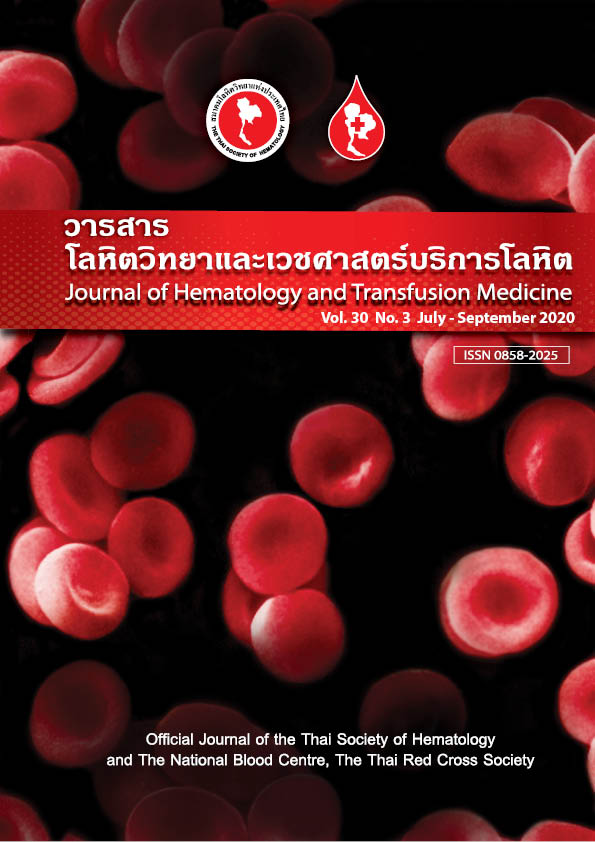Pre-transplant factors influencing HLA crossmatch in deceased donor kidney transplantation
Keywords:
HLA crossmatch, Deceased donors, Kidney transplantationAbstract
Abstract:
Introduction: Factor affecting the waiting list for deceased donor kidney transplantation is the retrieval time of the donor’s organs until a transplant kidney has been given to the patient. Hence, the delivery of the spleen and/or lymph nodes to the laboratory must be kept in the transport medium at the appropriate temperature. Besides, the HLA crossmatch testing time is another factor affecting kidney transplantation. Objective: To study retrospective information about factors affecting the HLA crossmatch test for kidney transplantation from deceased donors. Materials and Methods: The numbers of kidneys that could not be transplanted and the duration
of the HLA crossmatch test using complement-dependent cytotoxicity (CDC) and CDC-Antihuman globulin (CDC-AHG) for kidney transplantation from deceased donors to the patient candidates on waiting list of the Organ Donation Centre and the National Blood Centre, Thai Red Cross Society, to receive a kidney transplant were studied. Results: The total number of deceased donors was 1,233 cases with an upward trend every year. Fourteen samples from the deceased donors (1.13%) could not be used for HLA crossmatch test, owing to cell low viability (n = 13, 1.05%) and cell insufficiency for testing (n = 1, 0.08%). Moreover, the duration of testing time was approximately 5 to 6 hours, starting from obtaining the spleen and/or lymph nodes of the deceased donors to the time that the laboratory reported the results to the Organ Donation Centre. Conclusion: The important factors affecting the HLA crossmatch time before deceased donor kidney transplantation including not only specimen transportation but also the quality of laboratory management would be beneficial to support the increasing number of deceased kidney donors.
Downloads
References
In: Jirasiridham S, ed. Textbook of kidney donation for transplantation. Bangkok: Krungthepvejchasarn; 2001. p. 14-21.
2. O-Charoen R, Kupatawintu P, Sinsiri S, Salee S, Tatawatorn A, Nathalang O, et al. Preliminary results of selection criteria for cadaveric kidney transplantation by the Thai Red Cross. Transplant
Proc. 2000;32:1574-5.
3. Cecka JM. The UNOS renal transplant registry. In: Cecka JM, Terasaki PI, editors. Clinical transplants. Los Angeles: UCLA Immunogenetics Center; 2003. p. 1-20.
4. Irish WD, Ilsley JN, Schnitzler MA, Feng S, Brennan DC. A rich prediction model for delayed graft function in the current era of deceased donor renal transplantation. Am J Transplant. 2010;10:2279-86.
5. Ponticelli CE. The impact of cold ischemia time on renal transplant
outcome. Kidney Int. 2015;87:272-5.
6. Kayler L, Yu X, Cortes C, Lubetzky M, Friedmann P. Impact of cold ischemia time in kidney transplants from donation after circulatory death donors. Transplantation Direct. 2017;3:e177.
7. Debout A, Foucher Y, Trébern-Launay K, Legendre C, Kreis H, Mourad G, et al. Each additional hour of cold ischemia time significantly
increases the risk of graft failure and mortality following renal transplantation. Kidney Int. 2015;87:343-9.
8. Patel R, Terasaki PI. Significance of the positive crossmatch test in kidney transplantation. N Engl J Med. 1969;280:735-39
9. LeFor WM. Isolation of lymphocytes from lymph nodes and spleen. In: Hahn AB, Land GA, Strothman RM, editors. ASHI laboratory manual. 4th ed. New Jersey: American Society of Histocompatibility and Immunogenetics; 2000. p. (I.A.4) 1-4.
10. The OPTN/UNOS Histocompatibility Committee. Specimens for histocompatibility testing guidelines for OPOs. [cited on 20 May 2020] Available from: https://unos.org/wp-content/uploads/unos/Histo_Brochure.pdf.
11. Ounjai S, Ponraweethitikorn P, Kanunthong S, Srisuddee A, Phiencharoen
S, Kupatawintu P, et al. HLA-A, -B, and -DR frequencies in deceased kidney donors of the Organ Donation Centre, Thai Red Cross Society. J Hematol Transfus Med. 2019;29:175-81.
12. Altermann WW, Seliger B, Sel S, Wendt D, Schlaf G. Comparison of the established standard complement-dependent cytotoxicity and flow cytometric crossmatch assays with a novel ELISA-based HLA crossmatch procedure. Histol Histopathol. 2006;21:1115-24.
13. Annual report 2019 of The Organ Donation Centre, Thai Red Cross Society. [cited on 20 May 2020] Available from: https://www.organdonate.in.th/assets/files/odc2562.pdf.
14. Chapal M, Le Borgne F, Legendre C, Kreis H, Mourad G, Garrigue V, et al. A useful scoring system for the prediction and management
of delayed graft function following kidney transplantation from cadaveric donors. Kidney Int. 2014;86:1130-9.
15. Irish WD, Ilsley JN, Schnitzler MA, Feng S, Brennan DC. A risk prediction model for delayed graft function in the current era of deceased donor kidney transplantation. Am J Transplant. 2010;10:2279-86.
16. Shestha S, Bradbery L, Boal M, Blackmur JP, Watson CJE, Taylor CJ, et al. Logistic factors influencing cold ischemic time in
deceased donor kidney transplants. Transplantation. 2016;100:422-8.
17. Tupmongkol T, Kanunthong S, Boonpokkrong P, Tatawatorn A, Nathalang O, Attajarusit Y, et al. Implementation of real-time PCR for HLA typing in deceased donors. J Hematol Transfus Med. 2017;27:217-24.
18. Taylor CJ, Kosmoliaptsis V, Sharples LD, Prezzi D, Morgan CH, Key T, et al. Ten-Year experience of selective omission of the pretransplant crossmatch test in deceased donor kidney transplantation.
Transplantation. 2010;89:185-93.



